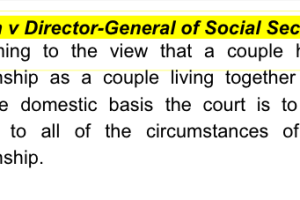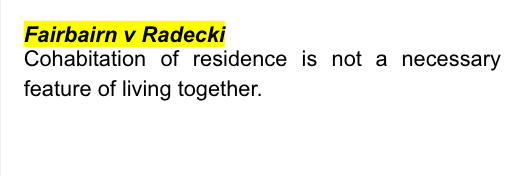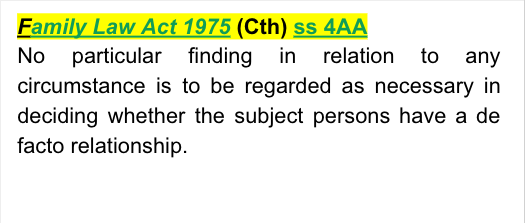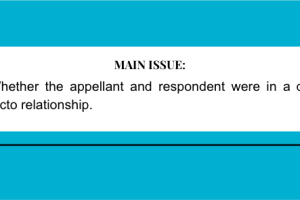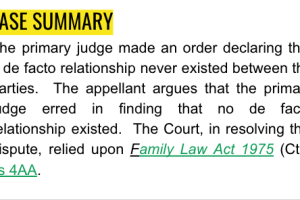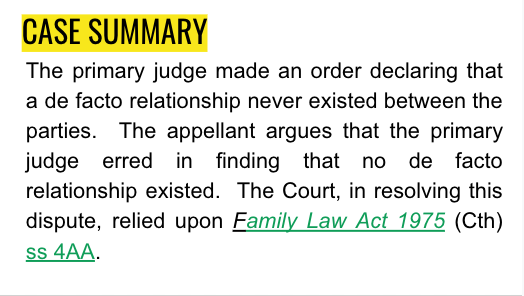- · 4742 friends
Parties Dispute Existence of De Facto Relationship

Shelby & Rylan [2022] FedCFamC1A 143 (19 September 2022)

The primary judge made an order declaring that a de facto relationship never existed between the parties. The appellant argues that the primary judge erred in finding that no de facto relationship existed. The Court, in resolving this dispute, relied upon Family Law Act 1975 (Cth) ss 4AA.

Facts
The appellant sought a declaration that a de facto relationship existed between the respondent and herself from 2007–2017. The respondent sought a declaration that a de facto relationship never existed between the parties. He conceded that whilst he and the appellant had a casual sexual relationship for about two years from when they met in 2004, and a spasmodic sexual relationship over a succeeding period of about three years, as well as maintaining a working relationship and friendship simultaneously and thereafter, nonetheless the nature of their relationship was not a de facto relationship as defined in the Act. The primary judge accepted the respondent’s arguments.
On 29 April 2022, following a 10 day hearing that commenced on 15 February 2021 and concluded on 16 September 2021, a judge of the Federal Circuit and Family Court of Australia (Division 1) made orders declaring that there was no de facto relationship between the appellant and respondent, and made a number of ancillary orders dealing with the interests of two third party interveners. The appellant asks this Court to set aside the declaration and orders made by the primary judge. If the appeal succeeds, the appellant seeks a declaration that a de facto relationship existed between 2007 and 2017 or, in the alternative, that the proceedings be remitted for rehearing. The respondent opposes the appeal.

Issue
Whether the appellant and respondent were in a de facto relationship.

Applicable law
Family Law Act 1975 (Cth) ss 4AA - highlights that no particular finding in relation to any circumstance is to be regarded as necessary in deciding whether the subject persons have a de facto relationship.



Analysis
The primary judge considered much of the evidence given by the appellant to have been self-serving and reconstructed rather than a truthful recitation of past events. Inconsistencies were found in the appellant’s affidavits in relation to significant issues including, for example, whether the appellant and respondent had lived together across two houses, as well as when the alleged de facto relationship had commenced. It is clear from the findings made by the primary judge that at no stage had the appellant, who was in receipt of a single parent payment, notified Centrelink that she was in a de facto relationship, a factor that the primary judge found was indicative of the appellant’s own belief that there was no such relationship.
The primary judge found that the parties had a casual sexual relationship between about 2005 and 2007, and a spasmodic sexual relationship from 2007–2011. There is no challenge to these findings. Thus, even if the parties had shared the same bed during their international travel together, it does not necessarily follow that they continued their casual or spasmodic sexual relationship on these occasions. This merely strengthens the primary judge’s ultimate conclusion at [194] that the composite picture of the relationship between the parties as established by the evidence, including the evidence of extensive shared travel, was not such as to persuade her Honour that it was the relationship of a couple living together on a genuine domestic basis at any time.
Conclusion
The Amended Notice of Appeal filed 4 August 2022 is dismissed. Within 60 days, the appellant pay the respondent’s costs of and incidental to the appeal agreed in the sum of $30,000.


